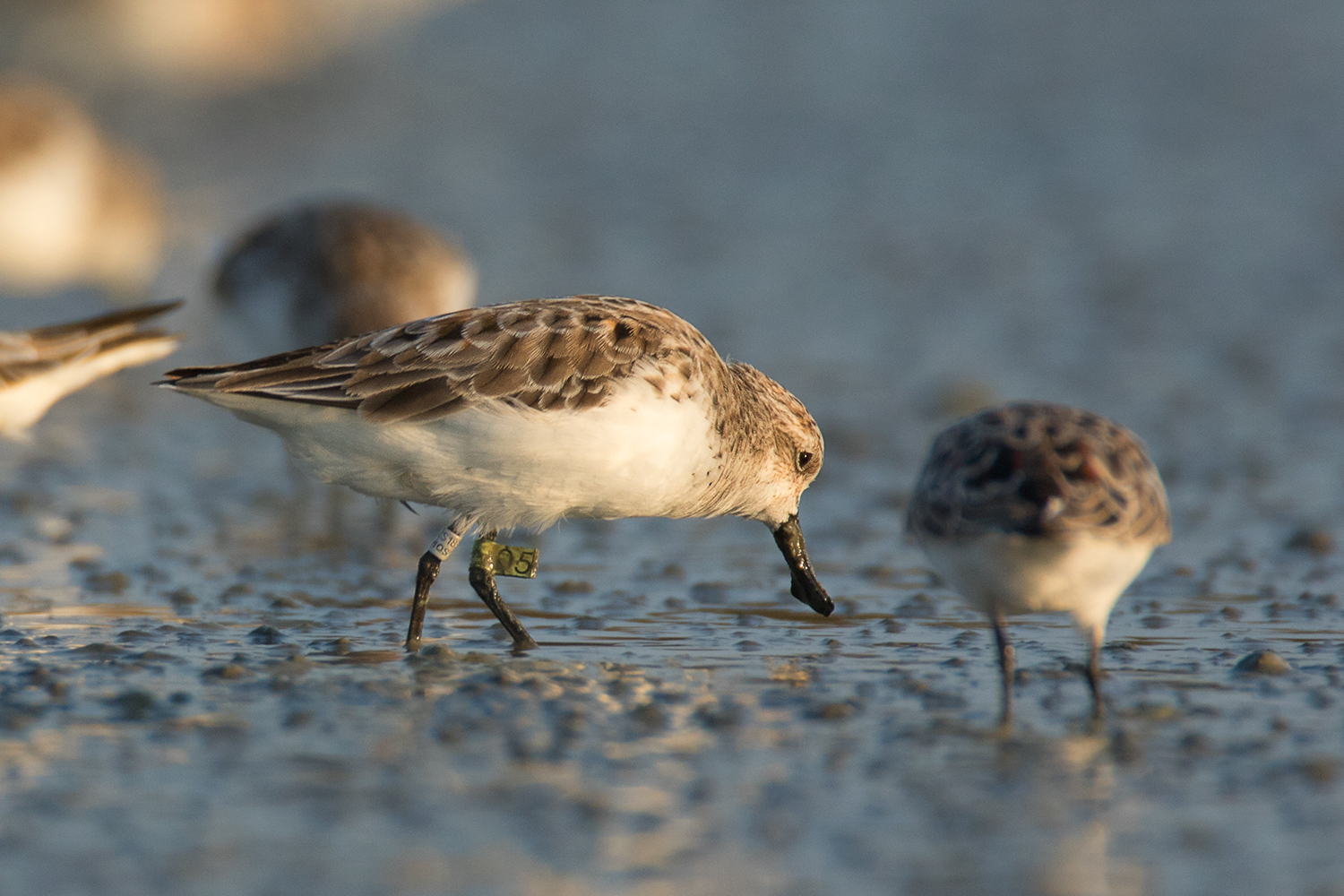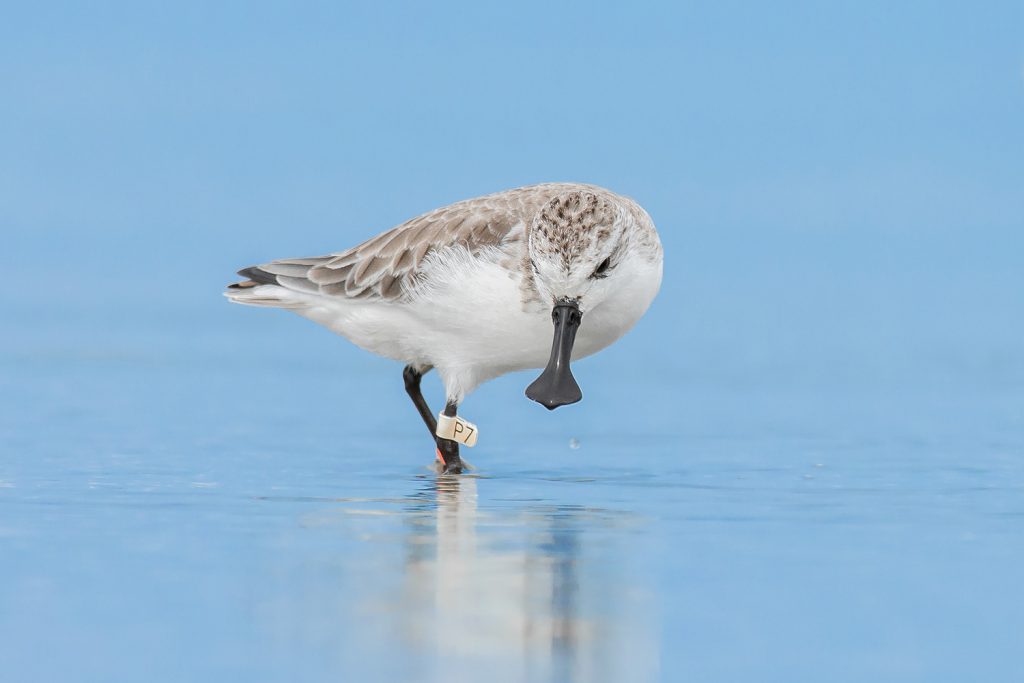
by Bird Conservation Society of Thailand
“On 20 June 2013, 8 Spoon-billed Sandpipers (Calidris pygmaea), one of rarest shorebirds of Asia, was ringed in the vicinity of Meinypil’gyno Village, Anadyr District, just south of the Arctic Circle in Chukotka Autonomous Area, Far East Russia. One of them got a lime green flag on the upper left leg with the numeric ‘05’ and leg band no.: MOSKVA KS18825.” said Pavel Tomkovich, Head of Ornithology Department of Zoological Museum, M.V.Lomonosov Moscow State University. He is one of the most experienced and respected scientists working on Arctic breeding birds, particularly Spoon-billed Sandpipers and other shorebirds.
‘Lime 05’ was first observed and photographed on her wintering grounds at Khok Kham, Samut Sakhon Province, Inner Gulf of Thailand on 30 November 2013 after a long distance migration covering over 7,500 km from Far East Russia. She remained there until at least 6 March 2014.
Khok Kham is located in the Inner Gulf of Thailand, it is a rural area in Samut Sakhon province, approximately 45 km from Bangkok. The area covers over 7,500 ha. Is dominated by salt pans and aquaculture ponds. It is an internationally important site for resident waterbirds and migratory shorebirds. Many species feed at the mudflats at low tide and roost in the salt pans during high tide. There are 189 resident and 84 migratory birds species, of which 12 species are listed as globally threatened such as Spoon-billed Sandpiper, Spotted Greenshank, Great Knot, Red Knot, Asian Dowitcher, Black-tailed Godwit, Bar-tailed Godwit, Eurasian Curlew and Far Eastern Curlew. It also the only place in SE Asia that Spoon-billed Sandpiper spend over-summering on 2011.
Khok Kham is also regarded as one of the Important Bird Area and Biodiversity (IBAs) by BirdLife International, an important site of the East Asian – Australasian Flyway (EAAF), to be designated as a Ramsar site for The Convention on Wetlands of International Importance. A recent project by The United Nations Development Programme (UNDP) is “Conserving Habitats for Globally Important Flora and Fauna in Production Landscapes” under The Global Environment Facility (GEF) has also selected Khok Kham as a focal area on conserving the Spoon-billed Sandpiper in Thailand.
In summer 2014, the pair of ‘Lime 05’ did not return to his nesting territory, so she had to move for about 14 kilometers to territory of a different male (it got then light green flag numeric 10). From that year till summer 2017: ‘Lime 05’ was nesting annually together with male ‘Lime 10’ in the same area.
In breeding season at Meinypil’gyno, first clutches of her eggs were always taken to incubator for head-starting programme by Russia ornithologist and an aviculturist from The Wildfowl & Wetlands Trust (WWT) from UK: hatched chicks were raised in captivity and released into wild after fledging. In most years the pair produced a replacement clutch, which was successful not every year. Because in the wild, Spoon-billed Sandpipers produce on average approximately 0.6 fledglings per pair. With head-starting programme, over 3 fledglings per pair could be produced.
Productivity of ‘Lime 05’ during 2013 – 2017:
2013 – 2 head-started birds released with leg flagged White JA, PA
2014 – 3 head-started birds released with leg flagged White Y8, E9, J9
2015 – 4 head-started birds released with leg flagged White L7, M7, P7, U7
‘White P7’ one of her sons was first observed and photographed on wintering grounds at Pak Thale, Petchaburi, Inner Gulf of Thailand on 28 November 2015. He came to be a regular visitor and has been observed for the third season now. Pak Thale is also regarded as one of the Important Bird and Biodiversity Areas (IBAs) by BirdLife International, and a Flyway Network site of the East Asian – Australasian Flyway (EAAF).

2016 – 4 head-started birds released with leg flagged White 0T, 0U, 0V, 0X. The pair was also used as foster parents for a chick (Lime M3) from a foreign nest.
2017 – 4 head-started birds released with leg flagged White 2A, 2C, 2H, 2L. Two chicks from a replacement clutch were flagged: Lime P6, T6.
Thus, in total 17 offspring of the ‘Lime 05’ were raised in captivity and released in 2013 – 2017. Moreover, after breeding season she continued to take on a long distance migration from Meinypil’gyno, Russia to Khok Kham, Thailand for the fifth winter and has been seen almost at the same spot every year. Before reaching Thailand ‘Lime 05’ was observed at China in Dongtai, Rudong on 02 May 2014 and in Tiaozini, Jiangsu on 23 September 2017. If any ‘Lime 05’ offspring was observed or photographed along the flyway, please report to Bird Conservation Society of Thailand or Spoon-billed Sandpiper Task Force Facebook. It is a very important information to save this species in long term.
Bird Conservation Society of Thailand (BCST, BirdLife Partner in Thailand) has been closely monitoring Spoon-billed Sandpipers since 1995, resulting in an impressive records of 7 flagged Spoon-billed Sandpipers: Lime 05, Lime 02, White OC, White P7, White AA, White U6 and Yellow 5(x)
For saving shorebird and their habitat, BCST is working with Thai’s government agencies such as The Department of National Park, Wildlife and Plant Conservation (DNP), Department of Marine and Coastal Resources (DMCR), Office of Natural Resources and Environmental Policy and Planning (ONEP), international organization such as The United Nations Development Programme (UNDP), BirdLife International, The Royal Society for the Protection of Birds (RSPB), Spoon-billed Sandpiper Task Force, East Asian – Australasian Flyway Partnership (EAAFP) and local communities in the on the assumption that appropriate tourism is a powerful incentive to conserve shorebird wintering areas.
The society also conducts midwinter Asian Waterbird Census (AWC) and Spoon-billed Sandpiper was included. The hope is that increased coverage of bird surveys, led by BCST’s field officers including Mr.Suchart Daengphayon (Mr.Tii) from Khok Kham, Samut Sakhon and Mr.Seri Manich (Mr.Dang) from Pak Thale, Petchaburi both now turned full-time shorebird conservationists, may reveal even more sighting of Spoon-billed Sandpipers in Thailand.
We must conserve and protect the Inner Gulf of Thailand as it is a key wintering site for migratory shorebird of South-East Asia and East Asian-Australasian Flyway. This can be best achieved through international supporting, corroborating and maintaining traditional low intensity usage of coastal areas such as salt farming and sustainable inshore fisheries. Future generations will certainly blame us if we do not act now to, limit increases of intensive industrial aquaculture, and conserve the wonderful wetland wilderness that lies only at our doorstep.
So far as we know, it seem like ‘Lime 05’ is a productive female and she is trying very hard to secure her species with a bit help from human. She has established a new Russia–Thailand relations as a little Russian Ambassador since 2013. If Spoon-billed Sandpiper is a flagship species for the protection of migratory shorebird and their habitat along EAAF, the ‘Lime 05’ should get respected as the “Queen of the Flyway”.
